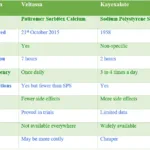Brand: VEOZAH
Drug Name: Fezolinetant
Manufacturer: Astellas Pharma
Primary Indication: Moderate to severe hot flashes in menopausal women
Date of FDA Approval: 12th May 2023
Hot flashes are not uncommon in women in their 5os. Some women may develop these symptoms in the early menopause or before the menopause has even started. Others may not develop any symptoms at all or develop hot flashes after menopause.
| You may also like to read: |
What is Menopause:
Menopause is a normal physiological state. It occurs when a woman’s reproductive years end. Usually, women in the ages between 45 and 55 develop menopause. In certain conditions such as premature ovarian failure, it can occur much earlier.
Menopause is due to decreased production of female hormones by the ovaries. When female hormones are low, women develop symptoms of menopause, including:
- Hot flashes (these are described by women as a sudden wave of heat coming from inside, burning like an internal fire, and feverish feelings)
- Irregular periods
- Night sweats
- Vaginal dryness and reduced libido
- Anxiety and sleep disturbances
- Weight gain and osteoporosis
Until now, no specific treatment effectively treats hot flashes. Some of the drugs that are used to treat hot flashes of menopause are:
- Hormonal therapy (estrogen or estrogen + progestin pills)
- SSRIs (Paroxetine and Escitalopram)
- SNRIs (Venlafaxine)
- Gabapentin or pregabalin
On 12th May, the FDA approved VEOZAH (Fezolinetant) for the treatment of moderate to severe hot flashes of menopause in women [Ref]. It is a trademark of Astellas Pharma.
VEOZAH (Fezolinetant) is one of the first drugs that block the neurokinins responsible for pain, hot flashes, and sweating.
| You may also like to read: |
VEOZAH (Fezolinetant) Dose for the treatment of moderate to severe Hot Flashes:
The usual dose is 45 mg, available as a single tablet, taken once daily without regard to meals but should be taken at the same time of the day.
The tablet can be taken with a glass of water without crushing or chewing it. Missed doses should not be covered up by taking two tablets. If a dose is missed, it can be taken within 8 to 12 hours, however, after 12 hours, wait for the next scheduled dose.
It is very important to check for liver dysfunction or abnormalities in liver functions before starting the treatment. LFTs should also be checked at 3 monthly intervals while on treatment.
| You may also like to read: |
Who should not take VEOZAH (Fezolinetant)?
Women with cirrhosis or advanced liver disease, marked renal impairment or ESRD, and women taking medicines that block CYP1A2 enzymes.
CYP1A2 inhibitors include:
- Fluvoxamine (Luvox):
- It is an antidepressant that strongly inhibits CYP1A2 and can significantly affect the metabolism of drugs metabolized by this enzyme.
- Ciprofloxacin (Ciproxin):
- It is an antibiotic from the fluoroquinolone class that moderately inhibits CYP1A2. It is important to be cautious when using Ciprofloxacin concurrently with drugs metabolized by CYP1A2.
- Fluoxetine (Prozac):
- This antidepressant has mild to moderate inhibitory effects on CYP1A2. It may affect the metabolism of certain medications.
- Cimetidine (Tagamet):
- It is a histamine-2 receptor antagonist used for the treatment of gastric ulcers and gastroesophageal reflux disease. Cimetidine can moderately inhibit CYP1A2.
- Zileuton (Zyflo):
- It is a medication used in the treatment of asthma and inhibits CYP1A2, potentially affecting the metabolism of other drugs.
- Mexiletine (Mexitil):
- It is a class 1B antiarrhythmic drug used to treat ventricular arrhythmias.
- Ticlopidine (Ticlid):
- It is an antiplatelet medication used to reduce the risk of stroke or heart attack. Ticlopidine has been found to inhibit CYP1A2 activity.
In addition, women with abnormal liver function tests, especially those with ALT or AST more than two times the upper limits of normal and bilirubin above the upper limits of normal should not take VEOZAH (Fezolinetant).
| You may also like to read: |
What are the side effects of VEOZAH (Fezolinetant)?
The most common side effects reported with VEOZAH (Fezolinetant) were GI related. These included Abdominal pain and Diarrhea.
Other commonly reported side effects not related to the GI tract were sleep disturbances, back pain, and elevated liver enzymes.
VEOZAH (Fezolinetant) Use in specific groups:
Pregnant women:
It has not been studied in pregnant women and is not indicated for the treatment of hot flashes other than those associated with menopause at which time it is unlikely for a woman to get pregnant.
Nursing woman:
It has not been studied and is not indicated in women who are breastfeeding.
Children:
It is not indicated in children
Renal impairment:
It is not indicated in women with renal impairment who have an eGFR of less than 30 ml/minute or those on dialysis. For mild and moderate renal impairment, adjustment in the dose is not necessary.
Liver disease:
It is contraindicated in women with cirrhosis and those with baseline deranged LFTs.
| You may also like to read: |
VEOZAH (Fezolinetant) MOA (Mechanism of action):
VEOZAH is a medication that blocks the activity of a specific receptor called the neurokinin 3 (NK3) receptor. By doing so, it prevents the binding of a substance called neurokinin B (NKB) to a group of neurons called kisspeptin/neurokinin B/dynorphin (KNDy) neurons.
This blocking action helps regulate the activity of these neurons in the part of the brain responsible for controlling body temperature.
Fezolinetant, the active component of VEOZAH, has a strong attraction to the NK3 receptor. It binds to this receptor with a high affinity, around 450 times more than it binds to NK1 or NK2 receptors.
Effect on QT interval: Does not prolong QT interval
Absorption: Absorption is not affected by food. It takes about 1 to 4 hours for the drug to reach the maximum concentration in the blood.
Protein binding: 51%
Half-life: 9.6 hours
Excretion: 76.9% in urine and 14.7% in feces
| You may also like to read: |




